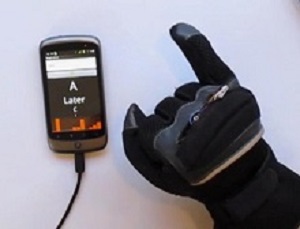 A glove fitted with wearable electronics can translate the American Sign Language (ASL) alphabet and then wirelessly transmit the text for display on electronic devices – all for less than $100, according to a study by Timothy O’Connor and Darren Lipomi from University of California – San Diego and colleagues.
A glove fitted with wearable electronics can translate the American Sign Language (ASL) alphabet and then wirelessly transmit the text for display on electronic devices – all for less than $100, according to a study by Timothy O’Connor and Darren Lipomi from University of California – San Diego and colleagues.
Current methods for tracking human body positions include cameras as well as optical systems involving infrared emitters and receivers. Both can yield good results but the former uses a lot of power, while emitters and receivers are expensive and immovable. Wearable sensor systems avoid these constraints, and gloves in particular are intuitive human-machine interfaces. Gloves that track people's gestures could provide a more seamless interface for applications from virtual reality to tele-surgery as well as for covert operations such as piloting aerial drones and controlling bomb-diffusing robots.
Lipomi and colleagues built a glove that decodes the ASL alphabet and then wirelessly transmits the text to electronic devices. The glove has nine flexible strain sensors – two on each finger and one on the thumb – that detect knuckle articulation. A microprocessor computes the ASL letter for each gesture, and a Bluetooth radio transmits the text for display. The system cost less than $100 to build and has low power requirements.
The researchers found that the wearable electronic glove determined all 26 letters of the ASL alphabet accurately. Based on fatigue studies of the sensors, the system will translate ASL letters accurately after the knuckles are bent maximally 1,000 times.
Moreover, the researchers found that data from the glove could also generate an accurate virtual display: when a real hand in the glove made the ASL gestures that spell "UCSD," a virtual hand mimicked them accurately. This, say the researchers, suggests new ways of using flexible, wearable electronics to interface with virtual environments. In addition, the glove can be a test system for evaluating the performance of new materials and stretchable hybrid electronics.
Abstract
This communication describes a glove capable of wirelessly translating the American Sign Language (ASL) alphabet into text displayable on a computer or smartphone. The key components of the device are strain sensors comprising a piezoresistive composite of carbon particles embedded in a fluoroelastomer. These sensors are integrated with a wearable electronic module consisting of digitizers, a microcontroller, and a Bluetooth radio. Finite-element analysis predicts a peak strain on the sensors of 5% when the knuckles are fully bent. Fatigue studies suggest that the sensors successfully detect the articulation of the knuckles even when bent to their maximal degree 1,000 times. In concert with an accelerometer and pressure sensors, the glove is able to translate all 26 letters of the ASL alphabet. Lastly, data taken from the glove are used to control a virtual hand; this application suggests new ways in which stretchable and wearable electronics can enable humans to interface with virtual environments. Critically, this system was constructed of components costing less than $100 and did not require chemical synthesis or access to a cleanroom. It can thus be used as a test bed for materials scientists to evaluate the performance of new materials and flexible and stretchable hybrid electronics.
Authors
Timothy F O’Connor, Matthew E Fach, Rachel Miller, Samuel E Root, Patrick P Mercier, Darren J Lipomi
[link url="http://journals.plos.org/plosone/"]PLOS material[/link]
[link url="http://journals.plos.org/plosone/article?id=10.1371/journal.pone.0179766"]PLOS One abstract[/link]
